Find A Verified Clinic
Trusted Upper Arm Lift Experts, Local to You
Easily connect with qualified, verified professionals for safe, reliable treatment.

No verified clinics found near St Minver.
Explore Clinics Near You on the Map
See exactly where verified Upper Arm Lift clinics are located across St Minver.
Zoom in, pan around, and click any marker to view each clinic’s profile, read reviews, and check their credentials before you book.

Your Upper Arm Lift Questions
Real Questions from Real People, Answered
Straightforward answers to the questions people like you are asking right now about Upper Arm Lift .

Price?.
Hi I hae no idea of costs would ypu be able to give me ball park costs for upper arm, thigh and breast lifts. Thank you
To view all the Upper Arm Lift questions, please click here.
Or click here to ask your own question.
Stay Informed with the Latest Aesthetic News & Offers
Join our free newsletter to receive updates on the latest treatments, safety guidance, and exclusive clinic offers near you.
No spam, just expert insights and trusted advice from the UK’s leading aesthetics directory.

